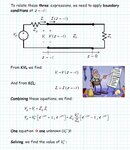Follow along with the video below to see how to install our site as a web app on your home screen.
Note: This feature may not be available in some browsers.


Here is how you can calculate Zin from your Z2 and ZL (different names used in my equation, but you get the idea).
View attachment 124769
Having that, you can calculate Γ1 from Zin and Z1.
Thanks PlanarMetamaterials,
So if I understand correctly, you are implying that Γ1=(Zin-Z1)/(Zin+Z1) and it won't change whether Z1 is an infinitely long transmission line or a discrete resistor. Right?
But here's why I got confused.
I was studying myself using U of Kentucky's Prof. Jim Stiles's lecture note and from section 2.6, page 4~5, he defines Γ1 as Γ2*e^(-2jβl) which is just phase shifted Γ2 and is independent of Z1.
Below is a screenshot of his lecture note.
View attachment 124780View attachment 124781
Why is that so?